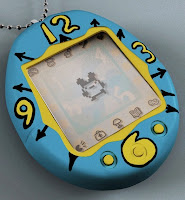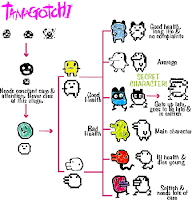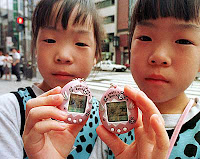Category: Uncategorized
Super Mario Rap
Tamagotchi, FarmVille, and “Fun Pain”
FarmVille is a game about periodic, repetitive action, grinding slowly over the course of days and weeks to a minor goal. When you get tired of grinding, you can spam your friends to get rewards faster. And eventually, when you get sick of that, you’ll pay to get where you need to be. Is this really fun? Well, it’s “fun pain”, as Roger Dickey of Zynga puts it.
Why do this to gamers? It’s a lucrative strategy. From 2009-2012, Zynga was a supergiant of social gaming, experiencing high growth and huge success, with millions of daily active users. Regardless of Zynga’s eventual fate, for those years they were king. Let’s get something straight; I’m not here to demonize Zynga. They capitalize on an evil mechanic, but it’s our job as game designers to create something both better and more lucrative than “fun pain”. With the current trend towards Freemium mobile apps and in-app purchases, this is a significant challenge, but I think we’re up to it. I’m here to tell you that in the long run, creating games that add value to people’s lives is a better strategy than getting them addicted to fun pain.

Tamagotchi was a virtual pet sold by Bandai in 1996, created by Japanese designer Aki Maita. Tamagotchi is responsible for the entire virtual pet craze, predating Pokemon(1996), Furby (1998), and current generation mobile pet-raising games like DragonVale (2011).

Tamagotchi is responsible for the periodic attention mechanic that “social gaming” is now known for. In order to keep your Tamagotchi alive, you had to check on it about once an hour. You pull it out of your pocket, feed it, play with it, clean up after it, and then that’s it. Nothing left to do after a couple minutes. You put it back in your pocket and wait for it to need you again. The more periodic attention you gave it, the better a final form it would achieve. Treat your Tamagotchi well, and you were rewarded with the cute and well-behaved Mametchi. Treat it poorly, and you were punished with the odious and short-lived Tarakotchi. You couldn’t pause the original Tamagotchi. It was a commitment. Tamagotchi could live anywhere from a month to years, and if it died early you knew it was your fault.
 If Tamagotchi and FarmVille have the same core mechanic, why do I still get a warm fuzzy feeling when I remember my Tamagotchi, but an oily prickling when I think about my days playing FarmVille? I think it has to do with the intent of the creators, and why and how they used the time mechanic. Tamagotchi’s real-time mechanic was designed not as a way to support in-app purchases and frustrate gamers, but to create a feeling of connection with a virtual creature. “I think it’s very important for humans to find joy caring for something” said Aki Maita of her creation. Maita didn’t just spout this truism, she designed and playtested for it. She spent weeks observing how high-school girls used her Tamagotchi prototypes, and used the feedback to optimize her pets for emotional attachment. Compare to the philosophy of Marc Pinkus, CEO of Zynga: “I don’t want innovation. You’re not smarter than your competitor. Just copy what they do and do it until you get their numbers.”
If Tamagotchi and FarmVille have the same core mechanic, why do I still get a warm fuzzy feeling when I remember my Tamagotchi, but an oily prickling when I think about my days playing FarmVille? I think it has to do with the intent of the creators, and why and how they used the time mechanic. Tamagotchi’s real-time mechanic was designed not as a way to support in-app purchases and frustrate gamers, but to create a feeling of connection with a virtual creature. “I think it’s very important for humans to find joy caring for something” said Aki Maita of her creation. Maita didn’t just spout this truism, she designed and playtested for it. She spent weeks observing how high-school girls used her Tamagotchi prototypes, and used the feedback to optimize her pets for emotional attachment. Compare to the philosophy of Marc Pinkus, CEO of Zynga: “I don’t want innovation. You’re not smarter than your competitor. Just copy what they do and do it until you get their numbers.”
 You can see the difference in intent in the way the time mechanic is handled. Tamagatchi is a living, feeling creature. When it needs to sleep, it sleeps. When it’s hungry, it whines at you. You can’t pay gems or gold to force it to stop being hungry. Compare to the more recent Dragon Story by Storm8– if it’s taking too long for an egg to hatch, you can pay gold to make it happen instantly. Rather than simulating a biological need, the game is transparently making you wait in order to bait you into paying. Periodic events aren’t a mechanic for you, the gamer, they’re a mechanic for the company to get you to pay them. The fact that it’s possible to pay a dollar to bypass waiting demonstrates how badly this mechanic is being abused. Waiting should be used as a mechanic to foster anticipation and surprise, not as a money grab.
You can see the difference in intent in the way the time mechanic is handled. Tamagatchi is a living, feeling creature. When it needs to sleep, it sleeps. When it’s hungry, it whines at you. You can’t pay gems or gold to force it to stop being hungry. Compare to the more recent Dragon Story by Storm8– if it’s taking too long for an egg to hatch, you can pay gold to make it happen instantly. Rather than simulating a biological need, the game is transparently making you wait in order to bait you into paying. Periodic events aren’t a mechanic for you, the gamer, they’re a mechanic for the company to get you to pay them. The fact that it’s possible to pay a dollar to bypass waiting demonstrates how badly this mechanic is being abused. Waiting should be used as a mechanic to foster anticipation and surprise, not as a money grab.
 I think that if creators keep in-mind the emotions and feelings they intend to instill in their audiences, and design their game mechanics around those rather than money, they will create happier games that enrich instead of detract from people’s lives. In the long term, success, fame, and money will come to those designers who seek to add value to players, rather than go for quick cash and addiction. Periodic gameplay is being derided as “skinner box” gameplay, but it doesn’t have to be that way. Social games and social mechanics don’t have to be evil. They can be used to give busy people fun, interesting toys that grow, change, and surprise them, to create virtual worlds that live and develop even when they aren’t playing. As game developers and designers, it’s our duty to create those worlds.
I think that if creators keep in-mind the emotions and feelings they intend to instill in their audiences, and design their game mechanics around those rather than money, they will create happier games that enrich instead of detract from people’s lives. In the long term, success, fame, and money will come to those designers who seek to add value to players, rather than go for quick cash and addiction. Periodic gameplay is being derided as “skinner box” gameplay, but it doesn’t have to be that way. Social games and social mechanics don’t have to be evil. They can be used to give busy people fun, interesting toys that grow, change, and surprise them, to create virtual worlds that live and develop even when they aren’t playing. As game developers and designers, it’s our duty to create those worlds.- Why you implement game mechanics is just as important as what mechanics you implement.
- If you have good intentions and design your mechanics to create good feelings in your players, it will show.
- Realtime mechanics don’t have to be evil. Use them to foster immersion and anticipation.
- Don’t allow people pay gems to avoid waiting. Make waiting part of the enjoyment of the game, or take it out.
- Don’t use realtime mechanics to hide your lack of content.
Concept: SpellBooks
Duke Nukem is back baby
Is interesting how 4 guys can make a better game experience for the fans for free, than what the original studios could have over 200 people working more than 10 years on the game. The game industry start to resemble more and more a crippled cow that does not give milk any more.
Check the link
http://www.moddb.com/mods/duke-nukem-forever
Aeon Flux pen n’ paper roll playing game
I’m working on a new pen n’ paper roll playing game, that is going to be based on the “Aeon Flux” weird, violent and sexual universe.
The core game system will take allot from the “Vampire the Masquerader’s” first edition game system, but it will be reworked and easier to use. I want to give the “Aeon Flux” roll playing game a fast story and action system, that gives the player possibilities to create unique characters.
Any dates of release are not set yet, but I’m hoping that it’s going to be released this year. And of course the game will be free for download on my page.
If you are an Illustrator that is interested doing illustrations that is going to be used for the “Aeon Flux” roll playing game, contact me by email: contact(@)mikaelsegedi.se
Legend of Mana – The Hidden Valley
For people that don’t know, I’m working for BigPoint right now, and they have a new game that is released now. It’s called GameGlobe and made by Square Enix.
I made a level for the game that was inspired by the “Secter of Mana” series. The name of the level is “Legend of Mana – The Hidden Valley”. and you can play it by selecting the link bellow:
New Concept: Beat ’em’ Up
This is a concept document that represents a formula for a good multiplayer fighting game. It is written in a way that a designer could easily add any theme and story on top of it.
Ceck it out!
http://www.mikaelsegedi.se/conceptbeatemup.pdf
Looking for new project
I’m now looking for new project. I did what was needed for project Empathy and now I’m moving on.
I wish you guys the best of luck!
I received allot of emails from people that are interested in me joining there team, and some of the missions I’ve received were rather interesting.
I have still not decided on which projects I’m going to work under. So for the people who are reading this and are interested in me joining there project, there is still time for you to contact me.



